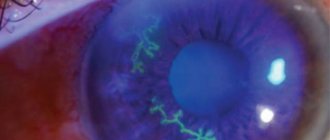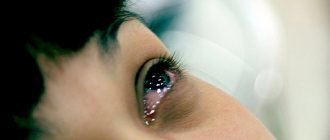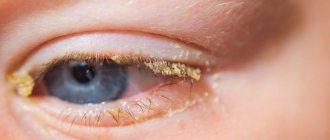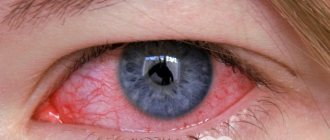Herpetic conjunctivitis is classified as a superficial form of the disease and is considered one of the most common. The causative agent of the disease penetrates the mucous membrane of the eye (conjunctiva) and triggers inflammatory processes and severe lesions in it.
The causative factor in the occurrence of this pathology is the Herpes simplex family of viruses - the oral type or herpes simplex virus -1 (HSV-1) and the genital type of the virus - HSV-2. The infection can penetrate the mucous membrane of the eye: with dust or dirt, through contact, through airborne droplets, through personal hygiene products, or when swimming in contaminated bodies of water. Unborn children (in utero from the mother) or newborns during the birth process can often become infected.
Causes
The herpes type of disease occurs due to infection with a virus. It is present in the body of almost every person. Activated against the background of decreased immunity. The following factors also contribute to this:
- failure to comply with personal hygiene rules;
- mucosal injuries;
- burns;
- damage by a foreign object;
- decreased immunity.
The infection enters the mucous membrane through airborne droplets. You can also become infected through contact. If herpes appears on the lips, then a person can independently transfer the infection to the eyes. Therefore, you should not touch them with dirty hands.
Risk group
This type of disease is common and tends to affect every person. This is due to the individuality of the body and immunity. Patients with the following factors may be at risk:
- chronic diseases;
- colds, flu;
- the presence of herpes on the lips and other parts of the body;
- children and old age;
- autoimmune, systemic diseases;
- violation of metabolic processes;
- Unhealthy Lifestyle.
Infection mainly occurs against the background of violation of sanitary rules.
What kind of disease is this?
Herpes conjunctivitis is a disease of the eye lining that is viral in nature. Appears due to the reproduction of the herpes virus on the conjunctiva and mucous membrane of the eye, provoked by one or more factors.
This virus remains dormant in the body for a long time, and can remain for life, periodically causing relapses. Under any favorable condition for its reproduction, it is activated, and the patient begins to feel the manifestation of the disease. So a person lives his whole life with a predisposition to this disease. This herpes virus can cause redness, watery eyes, and blisters form on the eyelid, which can often be seen in people prone to the disease in the autumn season.
Most often, children suffer from this disease, as they pay less attention to hygiene. But even an adult organism has a high chance of contracting an infection through touching the mucous membrane with dirty hands, handkerchiefs, or through a careless attitude towards the immune system.
In the photo below you can clearly see what herpetic conjunctivitis looks like:
Classification
This type of disease in ophthalmology is divided into the following forms:
- follicular - accompanied by severe symptoms: high fever, chills, friability of the conjunctiva, the presence of a rash in the form of small round blisters, mucous discharge, film formation in front of the eyes, redness, decreased visual acuity, cough and runny nose, severe weakness and malaise; characterized by slow development, requires immediate treatment;
- vesicular-ulcerative - accompanied by abundant purulent discharge, the appearance of ulcers and erosions on the edges of the eyelids, conjunctiva and sclera; after recovery, characteristic scars remain at the sites of the rash; often with this form of the disease, blepharospasm, uncontrolled lacrimation, sensitivity to light, decreased visual acuity appear;
- catarrhal - occurs rapidly and tends to pass quickly, rarely becomes chronic, accompanied by swelling, redness, and thick mucous discharge.
Only a doctor can determine the type of disease after a comprehensive examination.
Symptoms
The incubation period of the disease lasts from 3 to 14 days. Accompanied by characteristic signs and easily diagnosed. Main symptoms:
- the appearance of a film before the eyes;
- decreased visual acuity;
- the presence of mucous and purulent discharge;
- sticking of eyelids after sleep;
- decreased sensitivity of the cornea;
- a characteristic rash appears on the edges of the eyelids;
- redness of the eyelids, eyeball;
- swelling;
- uncontrollable lacrimation;
- pain that is accompanied by itching and burning;
- dry mucous membranes;
- feeling of a foreign object in the eye;
- blepharospasm;
- sensitivity to light;
- enlarged parotid lymph nodes;
- general malaise.
If you observe suspicious symptoms, you should immediately consult a doctor.
Photo
Photo of eyes affected by this disease.
Diagnostics
An accurate diagnosis can be made after laboratory tests. This is the only way to determine the pathogen. The doctor prescribes tests that will help identify the type of bacteria that has affected the conjunctiva and caused inflammation.
Bacterioscopic examination is mainly used. To do this, make a smear of the mucous membrane. Using a microscope, the presence of pathogenic microorganisms in the discharge from the conjunctiva is determined. Additionally, bacteriological culture is carried out. A special environment is created in the laboratory that promotes the development of bacteria. An enzyme immunoassay will also be required to determine the level of protective functions of the mucosa against the herpes virus. Using these diagnostic methods, the doctor determines the treatment method.
Diagnostic measures
Anamnestic indicators and a general examination will help determine the diagnosis without special examination methods. Such patients have a specific appearance. Patients' eyes are swollen, red, watery all the time, very sensitive to bright light, body temperature is elevated to low-grade levels. When determining visual acuity, it may be slightly reduced.
Characteristic signs of pathology are diagnosed using ophthalmometry.
Using ophthalmometry, you can examine specific changes in the conjunctiva, determine the presence of follicles, erosions, ulcers, and conflicts. This makes it possible to determine the diagnosis according to the classification. A mandatory diagnostic measure is to detect the virus in the isolated exudate. The diagnosis of herpes can be made only after the pathogen is detected by laboratory methods. Conjunctivitis can be caused by bacteria or fungus, so the choice of treatment methods depends on the cause.
Treatment
Ophthalmologists prescribe complex treatment, which consists of taking medications from different groups. Use products to treat affected areas of the mucous membrane. In this case, ophthalmic drops, gels, and ointments with antibacterial and anti-inflammatory effects are suitable.
Antiviral drugs
Drugs in this group contribute to inhibition and suppress the proliferation of microorganisms. Doctors prescribe the following drugs: Acyclovir, Bonafton, Lavomax, Anaferon, Zovirax. Additionally, it is recommended to add such ointments as Florenal and Bonafton. The frequency of receptions is 4-8 times a day.
Immune stimulation
With this form of the disease, it is very important to increase immunity. For this, the following drugs are prescribed: Cycloferon, Timalin, Amiksin. The products stimulate the body's protective functions.
Complex therapy
In addition to the previous drugs, anti-inflammatory drugs and glucocorticosteroids are additionally prescribed. They reduce swelling and inflammation of the conjunctiva. Dexamethasone and Acular are effective. Vitamin complexes and preparations for moisturizing the mucous membrane improve its functionality, relieve swelling and redness.
Doctors recommend: Artificial tear, Viziomax, Taufon. If the affected area is extensive, then it is necessary to take means to accelerate regeneration. For example, Korneregel.
Eyes, eyelids and conjunctiva must be treated with antiseptics. To do this, make a very weak solution of potassium permanganate, furatsilin, brilliant green. If itching is very bothersome, doctors prescribe antihistamines - Zodak, Zyrtec, Lecrolin.
It is important to consider that treatment can only be prescribed by a doctor. It is forbidden to take any medications on your own. This can significantly harm your health and cause irreversible complications.
Methods of therapy
To combat herpetic conjunctivitis, agents are used to stop the proliferation of microorganisms. It is necessary to use medications only after consultation with a doctor and examination. Self-medication in this situation is unacceptable. The following methods of therapy are usually used:
- Drops containing antibiotics (for example, Tobrex).
- Ointments that are placed under the eyelid (Virolex, Acyclovir).
- Oral medications (“Polyoxidonium”, “Cycloferon”) are prescribed for severe types of pathology.
- Zelenka for treating bubbles on the surface of the eyelids.
Complications
Infectious lesions often cause deformation of the eyelids. Against this background, eyelash growth is disrupted. Dangerous complications are meningitis, otitis media, sepsis. If newborn children encounter this disease, other ophthalmological pathologies may progress in them.
A dangerous consequence of this form of conjunctivitis is clouding of the cornea and dysfunction of the lacrimal gland. The herpesvirus species can also develop against the background of chickenpox. Usually manifests itself as a complication of such an infectious disease.
An advanced stage can cause decreased visual acuity and clouding of the cornea. These are dangerous consequences that are difficult to stop. Dysfunction of the lacrimal gland leads to the development of dry eye syndrome. You can get rid of it only after eliminating the main problem. Scars and marks may be left in place of the follicle. It depends on the extent of the damage.
Features of pathology therapy in young patients
Speaking about herpetic conjunctivitis in children, symptoms and treatment, it should be emphasized that the signs of the disease in minors are approximately the same as in adults.
However, slightly different methods of combating the disease are recommended. Typically, young patients are prescribed products containing interferons, for example, “Ophthalmoferon” in the form of drops. The drug is used five to six times a day for three days. The medication is only effective if it is placed in clean eyes. The patient needs regular treatment of the organs of vision with water or a decoction of chamomile. The patient should be provided with separate hygiene items, for example, a towel or scarf. For herpetic conjunctivitis in children, treatment also involves the use of products that include acyclovir.
Forecast
With timely and correct treatment, recovery will come quickly. In this case, there will be no risk of complications and serious consequences. In the initial stage, the disease is easily treatable. If the patient has reduced immunity or has autoimmune diseases, the following complications may develop:
- chronic form of the disease;
- herpetic keratoconjunctivitis (a dangerous disease that affects the cornea and can lead to vision loss);
- viral keratitis is an infectious pathology that is difficult to treat and causes vision loss.
Therefore, it is very important to contact an ophthalmologist at the first signs. After correct diagnosis, the doctor will be able to prescribe adequate therapy. Otherwise, the prognosis will be unfavorable.
Folk remedies for herpes conjunctivitis
In order to reduce unpleasant and very painful symptoms, ophthalmologists approve the use of various folk remedies that help eliminate ophthalmoherpes. Here are some recipes:
- Lotions and eye washes with strong water decoctions of eyebright, chamomile, plantain, cornflower, calendula, and pureed fennel seeds.
- Instillation and compresses of freshly squeezed aloe vera juice, previously diluted with water (proportion 1:10).
- Instillation of royal jelly diluted in water into the conjunctival bursa.
- Rinsing the eyes with a decoction of dried elderberry flowers.
- Instillation of colloidal silver NSP.
- Compresses from a decoction of marshmallow and barberry roots.
- Rinse the eye with egg white mixed with distilled water.
- Eye drops made from diluted bee honey in boiled water.
- Eye drops with a special solution of iodinol (blue iodine).
- Treatment of the eye with a warm, 20% aqueous solution of ground propolis.
To speed up recovery, you should adhere to a certain food menu, which should be balanced and rich in vitamins.
It should be remembered that self-prescription of any medications can only lead to suppression of the disease, and not to its effective treatment, therefore, only a specialized ophthalmologist should prescribe a treatment regimen.
Prevention
The herpetic form of conjunctivitis is very common. It may be accompanied by complications and become chronic. You can reduce the risk of developing this pathology by following simple rules of prevention. These include:
- Contact an ophthalmologist in a timely manner and undergo routine examinations 1-2 times a year.
- Strictly observe the rules of personal hygiene in any situation. It is strictly forbidden to use towels and other household items from another person. This increases the risk of contracting many diseases.
- When using contact lenses, you must take proper care of them. It is also recommended to use lenses made of high quality materials. After removal, they should be kept in a disinfectant solution.
- Clean the home and work area.
- Do not contact an infected person.
- Maintain a healthy lifestyle, eat right, exercise.
- Use sun protection glasses. If a person likes to visit public swimming pools, they should also wear goggles.
If a person has a reduced immune system, ophthalmologists may suggest taking a course of a polyvaccine. This is an effective prevention of this type of conjunctivitis. If a person suffers from such a pathology, he can infect others. Close people should take this information into account and protect themselves from infection. Maintaining hygiene will help with this.
This disease occurs very often and is accompanied by severe discomfort. A person cannot lead his usual lifestyle. Attempts at self-medication can result in the development of irreversible processes. Therefore, it is important to contact an ophthalmologist on time. This is the basic rule for the prevention of complications and chronic forms of conjunctivitis.











